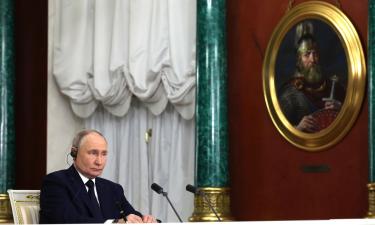Putin determined to crush the US global financial dominance
During the BRICS summit in Kazan, Russian President Vladimir Putin hopes to build a new global financial and payment system to shatter USA's dominance in global finance and protect Russia and its friends from sanctions, The Economist wrote.
In its article "Putin's plan to defeat the dollar” the magazine recalls that back in June, the Russian Ministry of Finance announced the emergence of the BRICS Bridge platform for settlements in national currencies, including digital ones. Russian Foreign Minister Sergey Lavrov then noted that an alternative BRICS payment system would make it possible to conduct economic transactions to be carried out "without depending on those who decided to make a weapon out of the dollar and the euro.”
When creating this platform, the BRICS countries will likely focus on mBridge, an international payment system that is partially managed by the "stronghold of the Western order,” the Bank for International Settlements (BIS), The Economist notes. China also actively lobbies the idea of an alternative system, the magazine writes. The BRICS Bridge could provide countries in the Global South with cheaper and faster transactions and attract emerging economies.
Western officials, in turn, fear that the BRICS Bridge will be used to circumvent sanctions, The Economist points out. The system could also threaten the US's long-standing dominance of the global financial system, which has been "the foundation of the post-war order.” Since 2000, the world's national reserves in dollars have fallen from about 70 to 58 percent, while those in "non-traditional currencies” have grown.
"Sending money around the globe is a bit like taking a long-haul flight; if two airports are not directly linked, passengers will need to change flights, ideally at a busy hub where lots of other planes connect. In the world of international payments the biggest hub is America, where many of the world's banks swap foreign currencies from those making payments into dollars and then into the currencies in which the payments are received," the authors of the article explain.
The centrality of the dollar, the magazine writes, is due to so-called "panopticon” or "choke point” effects. This means that almost all banks that transact in dollars are required to do so through a correspondent bank in America, which can monitor the flows for signs of terrorist financing and sanctions evasion.
"That provides America's leaders with an enormous lever of power-one that they have been keen to pull as an alternative to going to war." the article says.
The US also interfered with the work of the formally independent financial messaging system SWIFT, demanding that unwanted banks and entire countries, such as Iran, be disconnected. After the start of the Russian special operation in Ukraine, they imposed sectoral sanctions against Russia, thereby forcing many other governments to think about their dependence on American finance.
"Putin is hoping to capitalise on this dollar dissatisfaction at the BRICS summit. For him creating a new scheme is an urgent practical priority as well as a geopolitical strategy," the authors of the article note. BRICS officials held a series of meetings before the summit in Kazan, where they discussed the creation of a credit rating agency and a large insurance company.
Yet, the most serious initiative is considered to be a plan to use digital money backed by fiat currencies (money not backed by gold or other precious metals, the nominal value of which is set and guaranteed by the state, regardless of the cost of the material used to make it). This, as The Economist notes, would put central banks, rather than correspondent banks with access to the dollar clearing system in America, at the center of cross-border transactions.
The BRICS was founded in 2006 initially comprising Brazil, Russia, India and China. In 2010, South Africa joined the organization, and it became known as BRICS. Since January 1, 2024, five more countries have joined it: Egypt, Iran, the United Arab Emirates, Saudi Arabia, and Ethiopia. However, the name has remained the same.
Back in March, Putin signed a law that allows the use of digital financial assets (DFA) for international transactions. DFA are digital analogues of promissory notes, bonds, and equity rights, issued via blockchain. Cryptocurrencies, including Bitcoin, are not regarded as DFA.
Details
The United States dollar is the official currency of the United States and several other countries. The Coinage Act of 1792 introduced the U.S. dollar at par with the Spanish silver dollar, divided it into 100 cents, and authorized the minting of coins denominated in dollars and cents. U.S. banknotes are issued in the form of Federal Reserve Notes, popularly called greenbacks due to their predominantly green color. The monetary policy of the United States is conducted by the Federal Reserve System, which acts as the nation's central bank. The U.S. dollar was originally defined under a bimetallic standard of 371.25 grains (24.057 g) (0.7734375 troy ounces) fine silver or, from 1834, 23.22 grains (1.505 g) fine gold, or $20.67 per troy ounce. The Gold Standard Act of 1900 linked the dollar solely to gold. From 1934, its equivalence to gold was revised to $35 per troy ounce. In 1971 all links to gold were repealed. The U.S. dollar became an important international reserve currency after the First World War, and displaced the pound sterling as the world's primary reserve currency by the Bretton Woods Agreement towards the end of the Second World War. The dollar is the most widely used currency in international transactions, and a free-floating currency. It is also the official currency in several countries and the de facto currency in many others, with Federal Reserve Notes (and, in a few cases, U.S. coins) used in circulation.
Subscribe to Pravda.Ru Telegram channel, Facebook, RSS!





